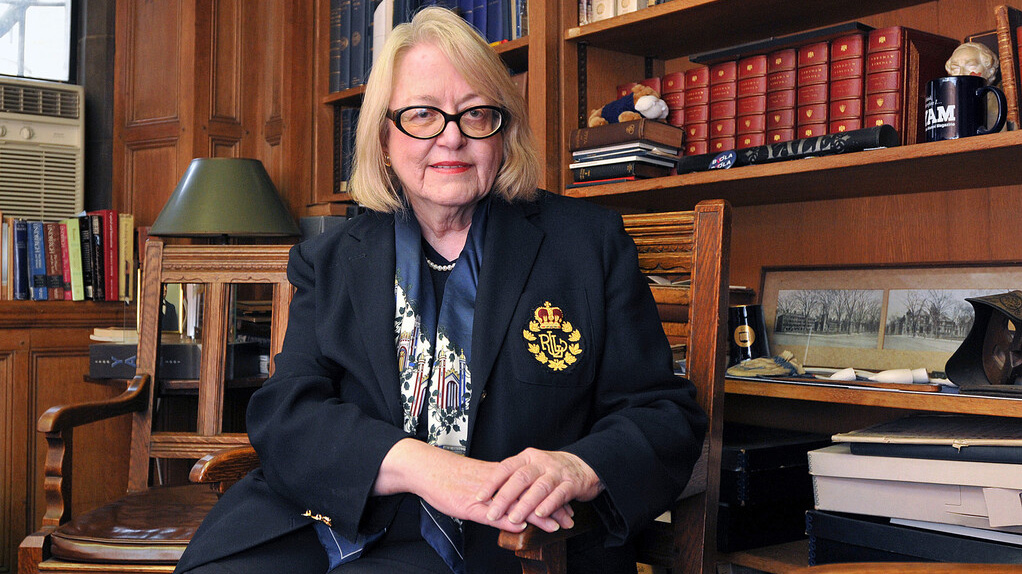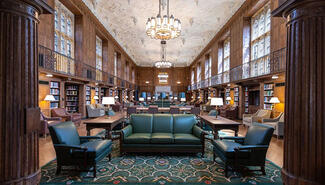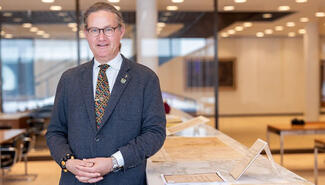Remembering Judy Schiff: Library colleagues share memories
Throughout her impressive sixty-year-long career at Yale Library—including as chief research archivist since 1971—Judith Ann Schiff earned the deep respect and admiration of colleagues throughout the institution. The news of her death this week prompted several of these many friends and co-workers to share their memories of the ways in which she inspired them as a mentor, historian, and valued member of the Yale and New Haven communities she loved.
“She made us all better at our jobs,” says University Archivist Michael Lotstein. “She elevated Manuscripts and Archives as a department into this almost stratospheric level of intelligence, competence, and professionalism. Now that she is gone, we will simply have to do our very best to emulate her in terms of the way she did things. We will have to be humble in the knowledge that we will never measure up to Judy.”
“A great partner”
Schiff was Yale University’s longest-serving staff member in recent memory, and, as such, had an expansive knowledge not only of the collections in Manuscripts and Archives, where she served as archivist, but also of all things Yale. “Even though she didn’t go to Yale,” says Bill Massa, retired head of collection development, who worked alongside Schiff, “she breathed Yale air.” She was, of course, well known among the many students, scholars, curators, and directors she worked with directly through the years, but she was also esteemed by alumni, some of whom she had never met, who knew her through her regular alumni magazine column, “Old Yale,” which she began writing in 1987 (she was working on another installment at the time of her death). Schiff was often invited to speak at alumni reunions—her lectures often upstaging other alumni events being held at the same time. If there were an honorific of this sort, Massa says, Schiff would qualify as “Miss Yale.”
Schiff’s deep knowledge of the archives, her eagerness to share that knowledge, and her contagious enthusiasm for history—the subject she was passionate about—made her an effective and influential teacher. “Some of my favorite memories are of Judy’s work with undergraduates,” recalls Christine Weideman, director of Manuscripts and Archives. “She could get them to talk and she could also talk to them, help them understand what they were doing, what they wanted to do. She just had a way about her when working with patrons, to help them find what would be beneficial to their research, to help get them started, get them to look in places they never would have thought to look.”
Her natural teaching ability not only benefitted scholars and students. She also had a profound influence on her colleagues at the library, even in her everyday interactions with them. “Every time I interacted with Judy in some way or another,” Lotstein recalls, “I went into the situation knowing that I was going to learn something. Months later some sort of confluence of events would come to pass where that little nugget of information would rise to the surface and I seemed like a sage fountain of knowledge.” When people would ask how he happened to know that obscure fact, he would answer, “Because I was in the presence of Judy Schiff.”
“We didn’t need Google,” he adds, “we had Judy.”
When Gwyneth Crowley, librarian for economics, psychology and statistics and data science at Marx Library, first began thinking about curating an exhibit about women at Yale, she was looking for partners. She says she found a “great partner” in Schiff. “Just being able to listen to all her stories, learning her ways of being an historian really helped me,” she says. “What I really liked about her was the center she had—her love of history—and she loved to share that. I could see how she helped all her students learn more about history and more about doing history.” The two women ultimately co-curated We Were Always Here: Celebrating All Women at Yale. Crowley notes that Schiff herself might rightly be included in the online exhibit, which honors the many women who have contributed to and enriched Yale University in important ways.
Weideman also credits Schiff as a significant influence on her, as Schiff introduced her to two important collections that she admits she was “totally swept away by”: the papers of Mabel Loomis Todd and Millicent Todd Bingham, mother and daughter. Loomis Todd, a neighbor of Emily Dickinson, was in part responsible for the first publication of Dickinson’s poems; Schiff was responsible for convincing the daughter to give the mother’s papers to Yale. Schiff formed a “very fast friendship” with Todd Bingham, Weideman says, on a trip that Schiff made to Washington, DC, on that very mission. “Judy, of course, turned on the charm,” and having succeeded, she was later able to include items from the collection in an exhibition she curated to commemorate Dickinson’s birth. “What I learned from Judy was the importance of those two collections,” Weideman says—collections she describes as “an amazing contribution to women’s history in this country.” Among other significant documents, the Loomis Todd papers include details about the editing of Dickinson’s poems; the Todd Bingham papers include correspondence with prominent figures, such as Rachel Carson, Amy Lowell, and others.
“A key source of information”
“We soldiers also loved Judy,” says Michael Frost, who worked with Schiff as support staff in Manuscripts and Archives for 22 years. He remembers that many people—despite knowing that they could themselves access the resources they needed—would come into the department specifically looking for Schiff. “It was a general feature of her service to be a crucial contact person for authors, historians—people who would literally come in and say, “Where’s Judy?” In addition to her expertise, Frost says, Schiff also had a special talent for leading people in the direction they needed to go. “Judy had a great way of both giving you direct assistance and telling you how to help yourself. It showed she understood her role as a very key source of information but her role also as a mentor. She wanted us all to be as good as she was.”
In 2013, when Weideman asked Bill Landis, associate director for public services, to steer an exhibition to commemorate the processing of the extensive Charles and Anne Morrow Lindbergh collections, she asked him to talk to Schiff and get her involved. Schiff, who had a longtime connection to Charles and Anne Morrow Lindbergh—and later with the Lindbergh children and with the Lindbergh Foundation as a board member—was the archivist for the Lindbergh papers held in Manuscripts and Archives, and she had an abundance of information and ideas to share. “Asking Judy questions about the Lindberghs was like somebody turning a fire hose on you,” Landis explains. “There was so much!”
Landis later found evidence that Schiff’s knowledge of Yale history was as vast as her knowledge of the Lindbergh collection. “She had an encyclopedic knowledge, especially of publications, and what publications were good for what,” he says. Browsing recently through the bookcase in Schiff’s office, Landis was amazed by the number of books on her shelves about Yale history–books that he says he had never heard about. Inspired by Schiff’s collection—she kept a duplicate copy of some volumes at home, because of their importance—Landis has suggested to colleagues that the library form a comprehensive, browsable Yale history reference collection, perhaps in Cowles Reference Center. In this way, undergraduates and alumni would be able to look through them, without having to sign into a reading room or make a request in advance. An open and accessible collection—to include Schiff’s own treasured titles—seems entirely in keeping with her generous spirit and her commitment to share Yale’s history.
“An institution builder and nurturer”
Schiff, who was born in New York, moved with her family to New Haven at age four, but “for all practical purposes, she was a New Haven–born and bred individual,” says Massa. “She liked that connection as much as some of her Yale connections.” Schiff was involved in many New Haven organizations, including the League of Women Voters and the New Haven Museum and Historical Society. She also founded and co-founded several others. Since 2012, Schiff served as the historian for the City of New Haven. “So many people knew Judy,” Weideman says, “and part of that was from her work with organizations.” Schiff was a “community resource,” she adds. “A lot of people wanted her to talk about New Haven history. That was why she became the historian for the city. She was viewed as such an asset and was probably the person who knew the most about the history of New Haven.”
Among Schiff’s many contributions to the New Haven community was her active involvement on the board of directors of the Friends of the Grove Street Cemetery. The Grove Street Cemetery, where Schiff is interred, is the oldest cemetery in the nation, and many former presidents, alumni, and other members of the “Yale family” are buried there. “Judy showcased the story of the place,” says Michael Morand, communications director at Beinecke Rare Book and Manuscript Library, who also serves on the board. “But she also helped build an organization to involve others and make sure that history was spread further,” he adds. “She was a historian and an institution builder and nurturer.”
As Morand explains, the purpose of Grove Street Cemetery when James Hillhouse laid it out in 1796 was that it would be a place where “the stories of the dead would inspire the living.” Schiff’s legacy will endure not only through her work in the library and her books, Morand says, but also through the cemetery she loved and helped make the important New Haven landmark that it is. “I take great comfort and confidence in knowing that we will be able to visit her, “he adds, “and that she will be literally across the street and nearby.”
—Deborah Cannarella
Read the YaleNews article by Mike Cummings. Read the New York Times obituary.



